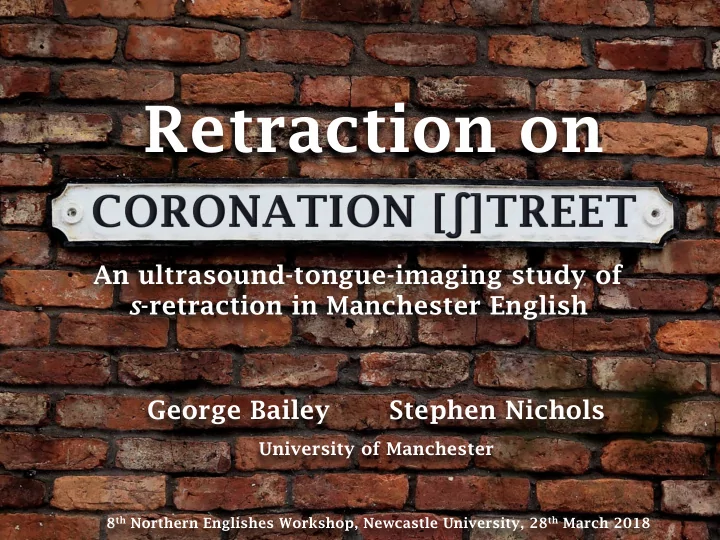

Retraction on An ultrasound-tongue-imaging study of s -retraction in Manchester English George Bailey Stephen Nichols University of Manchester 8 th Northern Englishes Workshop, Newcastle University, 28 th March 2018
Introduction 2 [s]treet.or.[ʃ]treet?
Introduction 3 What%we’re%looking%at%and%how%(and%why!):% What :......retraction.of.underlying./s/.to.a.more.[ʃ]-like.sound.in./stɹ/.and./stj/. clusters,.e.g.. street, string; stupid, student . How :........using.ultrasound.tongue.imaging.(with.simultaneous.acoustics). Why%#1 :..because.although.it’s.well-studied.in.American.English,.it.is.relatively. under-studied.in.British.English..BrE.also.has./stj/,.which.is.absent.in.AmE. Why%#2 :..characterised.as./s/- retraction% but.this.is.based.primarily.on.acoustic. data..Ultrasound.is.important.because.acoustics.does.not.have.a.one-to- one.mapping.with.articulation.(e.g..Mielke.et.al..2016.on.covert. articulation.of./ɹ/)
Background 4 Attested.throughout.the. US .(e.g..Labov.1984;.Durian.2007;.Gylfadottir.2015;. • Wilbanks.2017).and.the. UK .(Altendorf.2003;.Bass.2009;.Sollgan.2013;.Glain.2014). has.also.been.studied.in. New%Zealand .(Lawrence.2000).and. Australia . ‣ (Stevens.&.Harrington.2016),.although.only.the.phonetic.precursor.to.the. change.was.found.in.the.latter. Quite.often.the.focus.has.been.on.the.sociolinguistic.profile.of.this.change. • Relatively.less.work.on.the.phonetic.realisation. • Some.studies.have.adopted.a.binary.classification.(Janda.&.Joseph.2003;.Bass. rE:. ‣ 2009). But.Labov.(2001).argues.that.there.are.4.variants.differing.in.how.[ʃ]-like.they. ‣ are
What./ɹ/.the.reasons? 5 The.role.of./ɹ/.has.been.foregrounded.in.many.studies. • Baker.et.al..(2011).find.that.even.‘non-retractors’.show.a.coarticulatory.bias. ‣ towards. s -retraction.in.clusters.with./ɹ/..i.e../spɹ/,./skɹ/,./stɹ/. Shapiro.(1995).claims.that. s -retraction.in./stɹ/.clusters.is.a.case.of.non-local. ‣ assimilation.with./ɹ/.based.on.the.fact.that./s/.doesn’t.retract.in./st/.clusters,. e.g.. steep Alternatively,.the.role.of./ɹ/.could.be.more.indirect. • Lawrence.(2000).instead.claims.that.this. is% local.assimilation.-./ɹ/.triggers. ‣ affrication.of./t/.to./tʃ/,.which.then.triggers.retraction.of./s/. this.explanation.could.be.particularly.appropriate.in.British.contexts,.where. ‣ /t/.undergoes.a.similar.process.before./j/.for.most.speakers. e.g.. tune /tjuːn/.>.[tʃuːn]........ stupid /stjuːpɪd/.>.[ʃtʃuːpɪd]? ‣
Research.questions 6 • Categoricity.vs..gradience.in./s/-retraction. ‣ is.the.surface.realisation.of./s/.in./stɹ/.and./stj/.the.same.as.an.underlying./ʃ/?. ‣ not.just.with.respect.to.acoustics.but.also.articulation. • What.degree.of.inter-speaker.variation.do.we.find?.To.what.extent.do.we.find. different.‘systems’.of./s/-retraction?. • How.is.BrE.different.from.AmE.with.respect.to./s/-retraction?. ‣ what.happens.in./stj/.(absent.in.AmE).and.how.comparable.is.it.to./stɹ/?. ‣ is.the.affrication.of./t/.in./stɹ/.and./stj/.the.same.as.an.underlying./tʃ/?. ‣ what.does.this.suggest.about.the.mechanisms.that.trigger.this.process?.i.e..the. role.of./ɹ/
Methodology
Design.of.stimuli 8 9.word-initial.contexts Baselines.for.comparison:. Pseudo.distractors: underlying./s,.ʃ/ /tʃ/. /ɹ/. /s/. /ʃ/. e.g.. cheap e.g.. read e.g.. seep e.g.. sheep Retracting.environments: /tɹ/. /tj/. e.g.. treat e.g.. tune /stɹ/. /stj/. e.g.. street e.g.. stupid { + Useful.for.independent.evidence.of. what.happens.to./tɹ/.and./tj/. /st/. ? outside.of.post-/s/.environments e.g.. steep
Ultrasound.data.collection 10 Carrier.sentence:.‘I.know.[…].is.a.word’. • 5.repetitions.per.token.(130.sentences.in. • tongue.tip total). Synchronised.audio.recording.(lavalier.mic). • and.UTI.(60fps). Stabilised.with.headcage. • Mid-sagittal.view. • Currently.7.speakers.(2M;.5F).aged.18-26. • tongue.root ‣ all.born.(or.at.least.raised.from.age.4).in. Greater.Manchester,.but.in.some.cases. parents.aren’t.from.Manchester.(or. even.England)
Ultrasound.data.analysis 11 1 Forced.alignment.using.FAVE.(Rosenfelder.et.al..2011). • Recording ‣ manually-corrected,.with.further.sub-segmentation.e.g.. tree T.R.IY1.->.T.CH.R.IY1. 2 Tongue.splines.tracked.and.exported.using.AAA.(Articulate. • Instruments.Ltd..2011). FAVE. ‣ 3.keyframes.per.segment.-.analysis.conducted.on. (text-speech.. alignment) keyframe.2.(segment.mid-point). ‣ analysis.in.R.using. rticulate .(Coretta.2017).and. 3a 3b tidymv .(Coretta.2018).packages. AAA. Praat. Modelled.using.GAMMs.-.Generalised.Additive.Mixed. • (tongue.tracking) (acoustics) Models. ‣ ideal.for.modelling.non-linear.effects.in.dynamic.(time/ 4 space).data.(Sóskuthy.2017) R
Acoustics 12 To.complement.ultrasound.data,.acoustic.analysis.was.performed.in.Praat. • Centre%of%Gravity% (CoG).calculated.for.each.fricative/affricate.(DiCanio.2017). • lower.value.=.more./ʃ/-like;.higher.value.=.more./s/-like.(Jongman.et.al.. ‣ 2000;.Baker.et.al..2011) Sound pressure level (dB / Hz) Sound pressure level (dB / Hz) 20 20 0 0 -20 -20 0 1.102·10 4 0 1.102·10 4 Frequency (Hz) Frequency (Hz) /ʃ/.CoG:.3749.Hz /s/.CoG:.5743.Hz
Articulation
Articulation.-.M01 14 /s/ / ʃ / /st ɹ / /stj/ Tongue.body.for. /stɹ/ .and. /stj/ .completely. • overlapping.with. /ʃ/% Tongue.root.somewhat.intermediate. • between. /s/ .and. /ʃ/
Articulation.-.M02 15 /s/ / ʃ / /st ɹ / /stj/ Tongue.body.for. /stɹ/ .and. /stj/ .almost. • overlapping.with. /ʃ/ . But!% Tongue.root.of. /stɹ/ .and. /stj/% • overlapping.with. /s/
Articulation.-.F01 16 /s/ / ʃ / /st ɹ / /stj/ Distance.between. /s/ .and. /ʃ/ .much. • smaller. Less.‘retraction’.overall,.but. /stj/ . • more. /ʃ/ -like.than. /stɹ/
Articulation.-.F03 17 /s/ / ʃ / /st ɹ / /stj/ Almost.complete.overlap.between.all.four. • contexts,.particularly. /s/% and. /ʃ/% More.differentiation.at.tongue.tip,.but. • confidence.intervals.also.wider
Articulation.-.F06 18 /s/ / ʃ / /st ɹ / /stj/ Almost.complete.overlap.between.all.four. • contexts
Articulation.-.F07 19 /s/ / ʃ / /st ɹ / /stj/ Almost.complete.overlap.between.all.four. • contexts. More.differentiation.at.tongue.tip,.but. • confidence.intervals.also.wider
Articulation.-.F08 20 /s/ / ʃ / /st ɹ / /stj/ Slight.differentiation.at.tongue.root,.but.again. • lots.of.overlap.between.all.four.contexts. /stɹ/ .and. /stj/ .converge.on. /ʃ/ .at.tongue.tip. • but.are.more. /s/ -like.elsewhere
Interim.summary 21 M01.and.M02.seem.to.exhibit.‘categorical’.retraction.in.that.there.are.clearly.two. • groups.-. /s/ .vs.. /ʃ/ ~ /stɹ/ ~ /stj/% however,.the.tongue.shapes.of. /ʃ/ ,. /stɹ/ .and. /stj/ .still.differ.at.the.root.-.to. ‣ what.extent.can.we.call.this.categorical? Less.evidence.of.categoricity.for.F01,.F03,.F06,.F07,.F08. • but.is.that.just.because.they.have.much.less.differentiation.(sometimes. ‣ none!).between. /s/ .and. /ʃ/ .to.begin.with?
Difference.smooths 22 M01 Difference.smooths.between. /s/ .and. /ʃ/% 10 Est. difference in Y red.portions.(where.confidence.intervals.contain. ‣ 5 0).indicate.significant.differences.between.the. 0 two.curves. -5 difference more.red.=.more.differentiation.in.tongue.shape. ‣ -10 4.4 4.6 4.8 5.0 5.2 5.4 5.6 /s/ .and. /ʃ/ .completely.different.for.M01.and. ‣ M02;.F01.to.a.lesser.extent M02 F01 10 6 4 Est. difference in Y Est. difference in Y 5 2 0 0 -2 -5 difference difference -4 -6 4.5 5.0 5.5 6.0 4.6 4.8 5.0 5.2 5.4 5.6 5.8
Difference.smooths 23 But.for.four.speakers,.there.is.little-to-no.difference.in.tongue.shape.between. underlying. /s/ .and. /ʃ/% is.the.acoustic.contrast.between.these.two.still.maintained.despite.this. ‣ apparent.lack.of.articulatory.distinction? F03 F06 2 Est. difference in Y 5 Est. difference in Y 0 0 -2 difference -4 -5 difference 4.5 5.0 5.5 4.0 4.5 5.0 5.5 F07 F08 3 6 2 Est. difference in Y Est. difference in Y 4 1 2 0 -1 0 -2 -2 difference difference -3 -4 -4 -6 4.0 4.5 5.0 5.5 4.5 5.0 5.5
Acoustics. Part.I:./s/-retraction
Centre.of.Gravity 25 F01 F03 F06 stew 3 [stuː] 2 1 0 -1 F07 F08 M01 Centre of Gravity (normalised) 3 2 1 0 -1 /s/ /st/ /st ɹ / /stj/ / ʃ / /s/ /st/ /st ɹ / /stj/ / ʃ / M02 • All.speakers.still.have.an.acoustic.contrast.between. /s/ .and. /ʃ/ . 3 • Categorical.‘retraction’.for.three.speakers.(F01,.F03,.M01). 2 1 • i.e.. /s/ .vs.. /stɹ/ ,. /stj/ ,. /ʃ/% 0 • Gradient.‘retraction’.for.the.rest. -1 • i.e.. /stɹ/% and. /stj/% intermediate.between. /s/ .and. /ʃ/ /s/ /st/ /st ɹ / /stj/ / ʃ /
Acoustics 26 Crucially,.the.acoustic.analysis.reveals.that:. • 1. all .speakers.do.have.an.acoustic.contrast.between. /s/ .and. /ʃ/ . 2. all% speakers.exhibit.some.degree.of.acoustic.‘retraction’.in. /stɹ/ .and. /stj/% (whether.that.be.categorical.or.gradient) …but.in.terms.of.articulation,.remember.that. some .of.these.speakers.show.no. • apparent.lingual.differentiation.between.these.categories. this.applies.even.to.underlying. /s/ .and. /ʃ/ ! ‣
Acoustics. Part.II:./t/-affrication
Recommend
More recommend